The Development of a BMI-Guided Shape Morphing Technique and the Effects of an Individualized Figure Rating Scale on Self-Perception of Body Size
Abstract
1. Introduction
2. Materials and Methods
2.1. Participants
2.2. Survey Instruments
2.3. BMI-Guided Explicit Shape Morph
2.4. Procedure
2.5. Statistical Analysis
3. Results
4. Discussion
5. Conclusions
Author Contributions
Funding
Conflicts of Interest
References
- Farrell, C.; Lee, M.; Shafran, R. Assessment of body size estimation: A review. Eur. Eat. Disord Rev. 2005, 13, 75–88. [Google Scholar] [CrossRef]
- Greenleaf, C.; Starks, M.; Gomez, L.; Chambliss, H.; Martin, S. Weight-related words associated with figure silhouettes. Body Image 2004, 1, 373–384. [Google Scholar] [CrossRef] [PubMed]
- Mölbert, S.C.; Thaler, A.; Mohler, B.J.; Streuber, S.; Romero, J.; Black, M.J.; Zipfel, S.; Karnath, H.O.; Giel, K.E. Assessing body image in anorexia nervosa using biometric self-avatars in virtual reality: Attitudinal components rather than visual body size estimation are distorted. Psychol. Med. 2018, 48, 642–653. [Google Scholar] [CrossRef]
- Fitzgibbon, M.L.; Blackman, L.R.; Avellone, M.E. The relationship between body image discrepancy and body mass index across ethnic groups. Obes. Res. 2000, 8, 582–589. [Google Scholar] [CrossRef] [PubMed]
- Pulvers, K.M.; Lee, R.E.; Kaur, H.; Mayo, M.S.; Fitzgibbon, M.L.; Jeffries, S.K.; Butler, J.; Hou, Q.; Ahluwalia, J.S. Development of a culturally relevant body image instrument among urban African Americans. Obes. Res. 2004, 12, 1641–1651. [Google Scholar] [CrossRef] [PubMed]
- Stunkard, A.J.; Sørensen, T.; Schulsinger, F. Use of the Danish Adoption Register for the study of obesity and thinness. Res. Publ. Assoc. Res. Nerv. Ment. Dis. 1983, 60, 115–120. [Google Scholar]
- Flynn, K.J.; Fitzgibbon, M. Body images and obesity risk among Black females: A review of the literature. Ann. Behav. Med. 1998, 20, 13–24. [Google Scholar] [CrossRef]
- Patt, M.R.; Lane, A.E.; Finney, C.P.; Yanek, L.R.; Becker, D.M. Body image assessment: Comparison of figure rating scales among urban Black women. Ethn. Dis. 2002, 12, 54–62. [Google Scholar]
- Williamson, D.A.; Womble, L.G.; Zucker, N.L.; Reas, D.L.; White, M.A.; Blouin, D.C.; Greenway, F. Body image assessment for obesity (BIA-O): Development of a new procedure. Int. J. Obes. Relat. Metab. Disord. 2000, 24, 1326–1332. [Google Scholar] [CrossRef]
- Moelbert, S.C.; Klein, L.; Thaler, A.; Mohler, B.J.; Brozzo, C.; Martus, P.; Karnath, H.O.; Zipfel, S.; Giel, K.E. Depictive and metric body size estimation in anorexia nervosa and bulimia nervosa: A systematic review and meta-analysis. Clin. Psychol. Rev. 2017, 57, 21–31. [Google Scholar] [CrossRef]
- Voges, M.M.; Giabbiconi, C.M.; Schöne, B.; Braks, K.; Huber, T.J.; Waldorf, M.; Hartmann, A.S.; Vocks, S. Double standards in body evaluation? How identifying with a body stimulus influences ratings in women with anorexia nervosa and bulimia nervosa. Int. J. Eat. Disord. 2018, 51, 1223–1232. [Google Scholar] [CrossRef] [PubMed]
- Cash, T.F.; Deagle, E.A. The nature and extent of body-image disturbances in anorexia nervosa and bulimia nervosa: A meta-analysis. Int. J. Eat. Disord. 1997, 22, 107–125. [Google Scholar] [CrossRef]
- Gledhill, L.J.; George, H.R.; Tovée, M.J. Perceptual not attitudinal factors predict the accuracy of estimating other women’s bodies in both women with anorexia nervosa and controls. Front. Psychol. 2019, 10, 997. [Google Scholar] [CrossRef] [PubMed]
- de Vignemont, F. Body schema and body image-Pros and cons. Neuropsychologia 2010, 48, 669–680. [Google Scholar] [CrossRef] [PubMed]
- Longo, M.R. Implicit and explicit body representations. Eur. Psychol. 2015, 20, 6–15. [Google Scholar] [CrossRef]
- Altabe, M.; Thompson, J.K. Size estimation versus figural ratings of body image disturbance: Relation to body dissatisfaction and eating dysfunction. Int. J. Eat. Disord. 1992, 11, 397–402. [Google Scholar] [CrossRef]
- Garner, D.M.; Olmstead, M.P.; Polivy, J. Development and validation of a multidimensional eating disorder inventory for anorexia nervosa and bulimia. Int. J. Eat. Disord. 1983, 2, 15–34. [Google Scholar] [CrossRef]
- Pulvers, K.; Bachand, J.; Nollen, N.; Guo, H.; Ahluwalia, J.S. BMI-based norms for a culturally relevant body image scale among African Americans. Eat. Behav. 2013, 14, 437–440. [Google Scholar] [CrossRef]
- Cash, T.F.; Fleming, E.C. The impact of body image experiences: Development of the body image quality of life inventory. Int. J. Eat. Disord. 2002, 31, 455–460. [Google Scholar] [CrossRef]
- Thaler, A.; Geuss, M.N.; Mohler, B.J. The role of visual information in body size estimation. Iperception 2018, 9, 2041669518796853. [Google Scholar] [CrossRef]
- Thaler, A.; Piryankova, I.; Stefanucci, J.K.; Pujades, S.; de la Rosa, S.; Streuber, S.; Romero, J.; Black, M.J.; Mohler, B.J. Visual perception and evaluation of photo-realistic self-avatars from 3D body scans in males and females. Front. ICT 2018. [Google Scholar] [CrossRef]
- Thaler, A.; Geuss, M.N.; Mölbert, S.C.; Giel, K.E.; Streuber, S.; Romero, J.; Black, M.J.; Mohler, B.J. Body size estimation of self and others in females varying in BMI. PLoS ONE 2018. [Google Scholar] [CrossRef] [PubMed]
- Cornelissen, P.L.; Cornelissen, K.K.; Groves, V.; Mccarty, K.; Tovée, M.J. View-dependent accuracy in body mass judgements of female bodies. Body Image 2018, 24, 116–123. [Google Scholar] [CrossRef] [PubMed]
- Dratva, J.; Bertelsen, R.; Janson, C.; Johannessen, A.; Benediktsdóttir, B.; Bråbäck, L.; Dharmage, S.C.; Forsberg, B.; Gislason, T.; Jarvis, D.; et al. Validation of self-reported figural drawing scales against anthropometric measurements in adults. Public Health Nutr. 2016, 19, 1944–1951. [Google Scholar] [CrossRef]
- Piryankova, I.V.; Stefanucci, J.K.; Romero, J.; De La Rosa, S.; Black, M.J.; Mohler, B.J. Can I recognize my body’s weight? The influence of shape and texture on the perception of self. ACM Trans. Appl. Percept. 2014, 11. [Google Scholar] [CrossRef]
- Irvine, K.R.; Mccarty, K.; Pollet, T.V.; Cornelissen, K.K.; Tovée, M.J.; Cornelissen, P.L. The visual cues that drive the self-assessment of body size: Dissociation between fixation patterns and the key areas of the body for accurate judgement. Body. Image 2019, 29, 31–46. [Google Scholar] [CrossRef]
- Allen, B.; Curless, B.; Popovic, Z. The space of human body shapes: Reconstruction and parameterization from range scans. ACM Trans. Graph. 2003. [Google Scholar] [CrossRef]
- Lu, Y.; Zhao, S.; Younes, N.; Hahn, J.K. Accurate nonrigid 3D human body surface reconstruction using commodity depth sensors. Comput. Animat. Virtual. Worlds 2018. [Google Scholar] [CrossRef]
- Cash, T.F.; Jakatdar, T.A.; Williams, E.F. The body image quality of life inventory: Further validation with college men and women. Body Image 2004. [Google Scholar] [CrossRef]
- Cash, T.F.; Phillips, K.A.; Santos, M.T.; Hrabosky, J.I. Measuring “negative body image”: Validation of the Body Image Disturbance Questionnaire in a nonclinical population. Body Image 2004. [Google Scholar] [CrossRef]
- Cash, T.F.; Fleming, E.C.; Alindogan, J.; Steadman, L.; Whitehead, A. Beyond body image as a trait: The development and validation of the body image states scale. Eat. Disord. 2002, 10, 103–113. [Google Scholar] [CrossRef] [PubMed]
- Thompson, J.K.; Schaefer LMThomas, F. Cash: A multidimensional innovator in the measurement of body image; Some lessons learned and some lessons for the future of the field. Body Image 2019, 31, 198–203. [Google Scholar] [CrossRef] [PubMed]
- Hrabosky, J.I.; Cash, T.F.; Veale, D.; Neziroglu, F.; Soll, E.A.; Garner, D.M.; Strachan-Kinser, M.F.; Bakke, B.; Clauss, L.J.; Phillips, K.A. Multidimensional body image comparisons among patients with eating disorders, body dysmorphic disorder, and clinical controls: A multisite study. Body Image 2009, 6, 155–163. [Google Scholar] [CrossRef] [PubMed]
- Siri WiE. Body Composition from Fluid Spaces and Density: Analysis of Methods; University of California: Berkeley, CA, USA, 1956. [Google Scholar]
- Ortiz, O.; Russell, M.; Daley, T.L.; Baumgartner, R.N.; Waki, M.; Lichtman, S.; Wang, J.; Pierson, R.N., Jr. Differences in skeletal muscle and bone mineral mass between black and white females and their relevance to estimates of body composition. Am. J. Clin. Nutr. 1992, 55, 8–13. [Google Scholar] [CrossRef]
- Poulton, E.C. Bias in Quantifying Judgments; Lawrence Erlbaum Associates: East Sussex, UK, 1989. [Google Scholar]
- Keeton, W.P.; Cash, T.F.; Brown, T.A. Body image or body images?: Comparative, multidimensional assessment among college students. J. Pers. Assess. 1990, 54, 213–230. [Google Scholar] [CrossRef] [PubMed]
- Thompson, J.K.; Stice, E. Thin-ideal internalization: Mounting evidence for a new risk factor for body-image disturbance and eating pathology. Curr. Dir. Psychol. Sci. 2001, 10, 181–183. [Google Scholar] [CrossRef]
- Tiggemann, M.; McGill, B. The role of social comparison in the effect of magazine advertisements on women’s mood and body dissatisfaction. J. Soc. Clin. Psychol. 2004, 23, 23–44. [Google Scholar] [CrossRef]
- Tiggemann, M.; Slater, A.; Bury, B.; Hawkins, K.; Firth, B. Disclaimer labels on fashion magazine advertisements: Effects on social comparison and body dissatisfaction. Body Image 2013, 10, 45–53. [Google Scholar] [CrossRef]
- Carlson, S.A.; Adams, E.K.; Yang, Z.; Fulton, J.E. Percentage of deaths associated with inadequate physical activity in the United States. Prev. Chronic. Dis. 2018, 15, E38. [Google Scholar] [CrossRef]
- Colberg, S.R.; Sigal, R.J.; Yardley, J.E.; Riddell, M.C.; Dunstan, D.W.; Dempsey, P.C.; Horton, E.S.; Castorino, K.; Tate, D.F. Physical activity/exercise and diabetes: A position statement of the American Diabetes Association. Diabetes Care 2016, 39, 2065–2079. [Google Scholar] [CrossRef]
- McTiernan, A.N.; Friedenreich, C.M.; Katzmarzyk, P.T.; Powell, K.E.; Macko, R.I.; Buchner, D.; Pescatello, L.S.; Bloodgood, B.; Tennant, B.E.; Vaux-Bjerke, A.; et al. Physical activity in cancer prevention and survival: A systematic review. Med. Sci. Sports Exerc. 2019, 51, 1252–1261. [Google Scholar] [CrossRef] [PubMed]

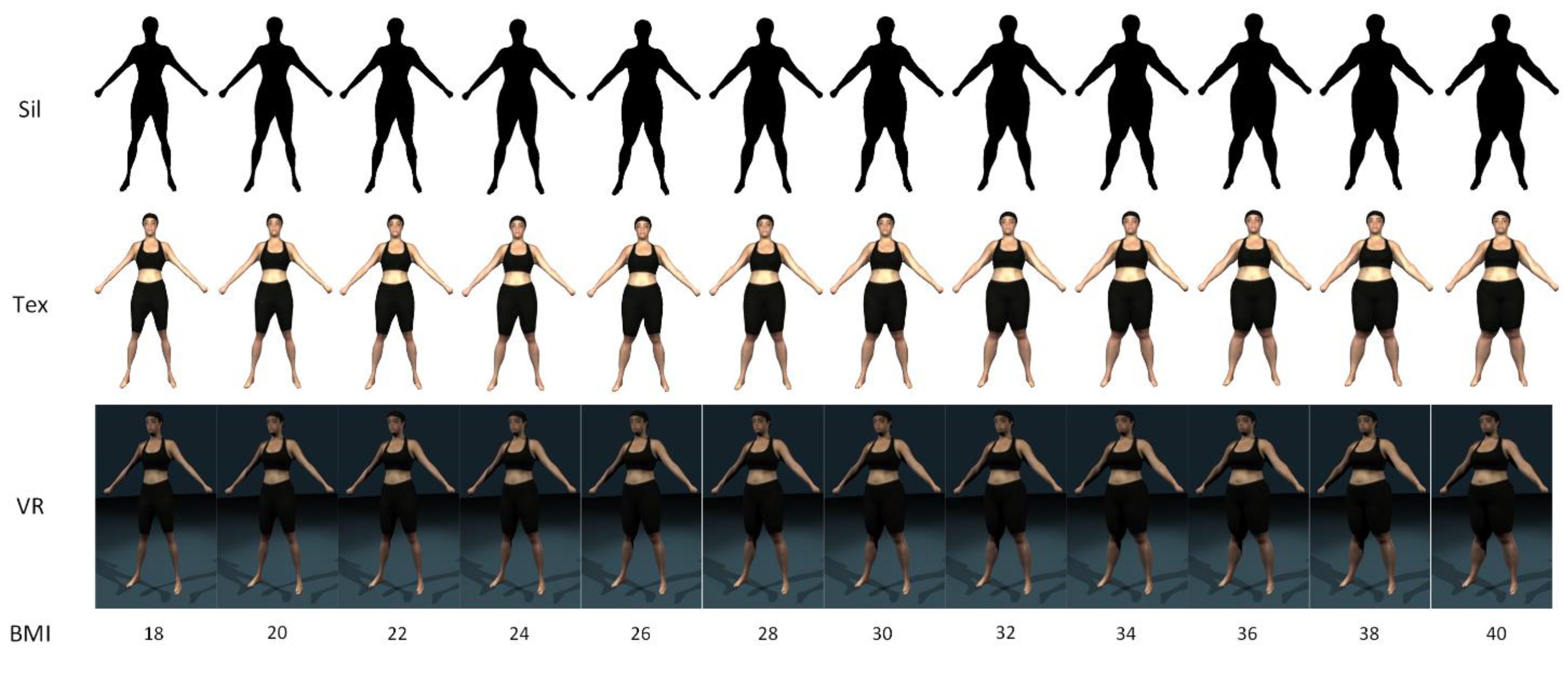
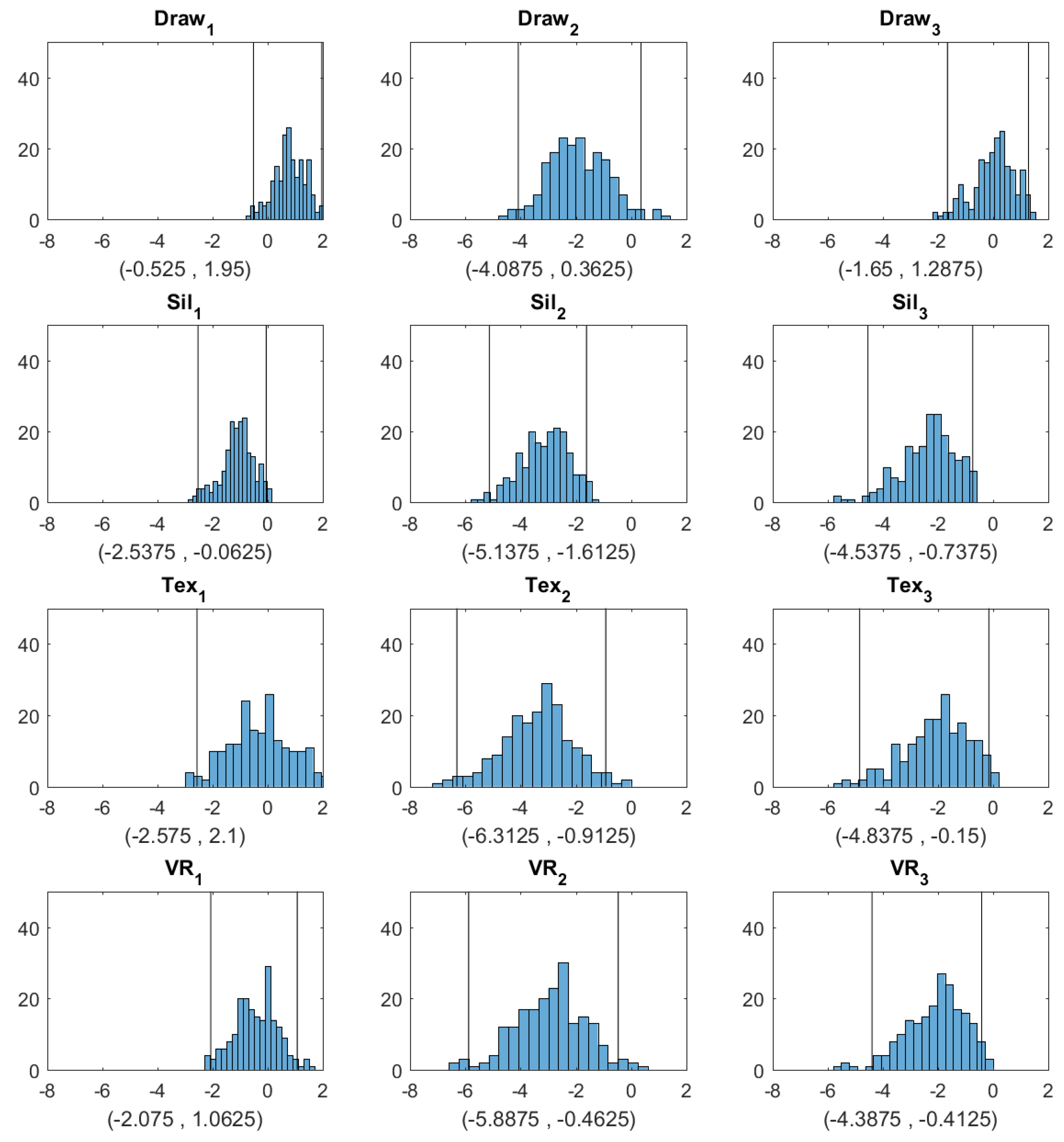
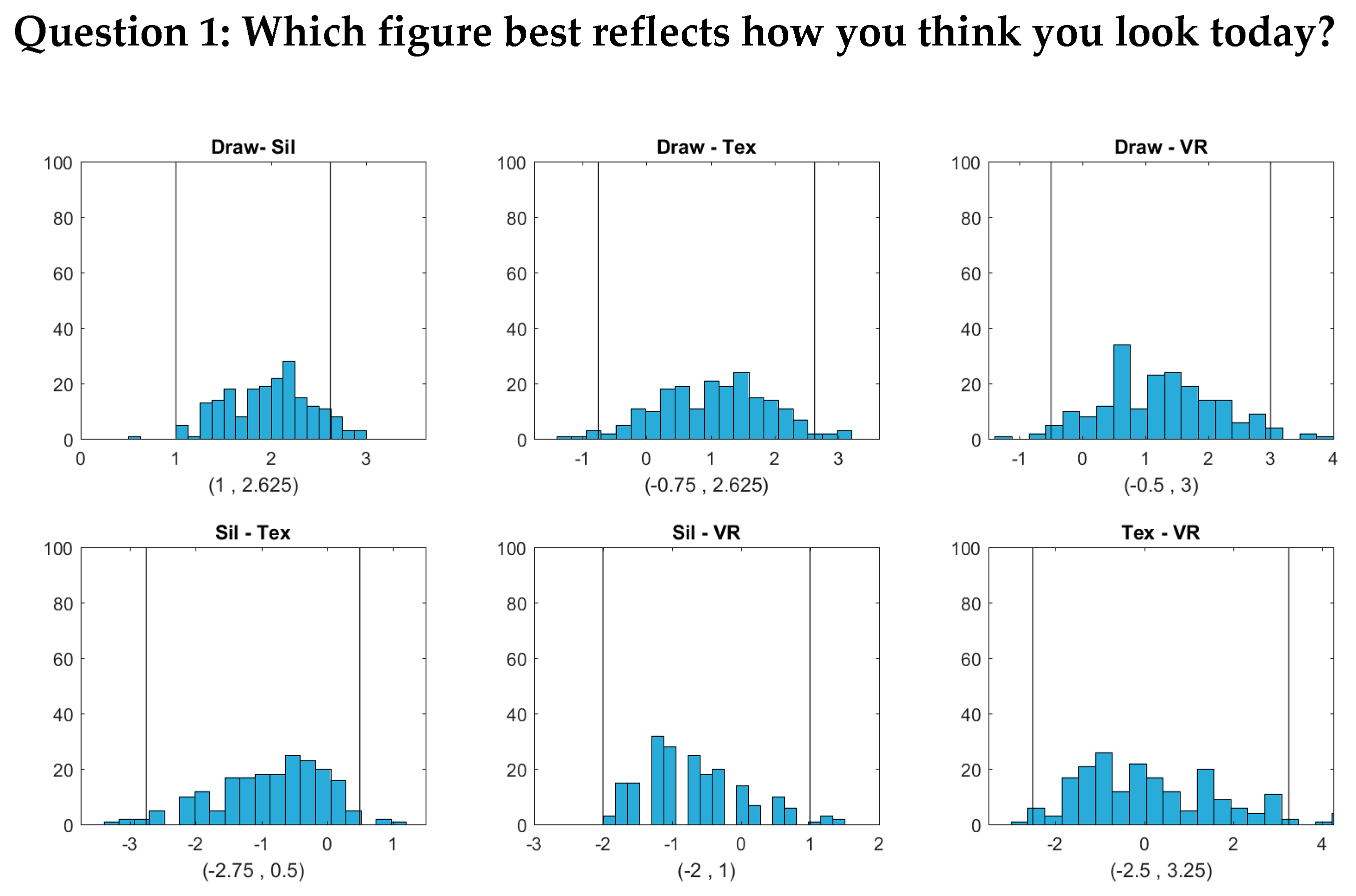
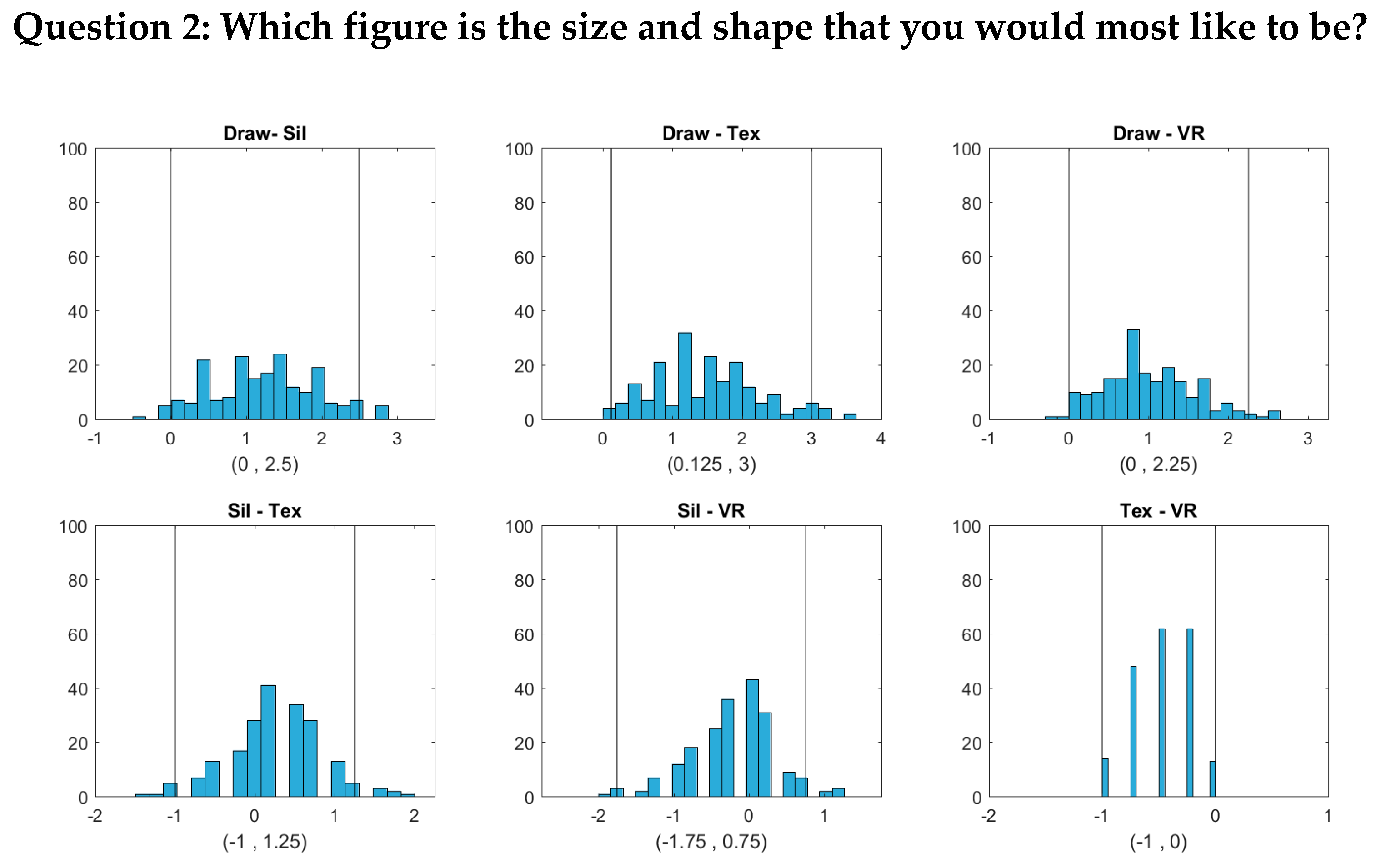
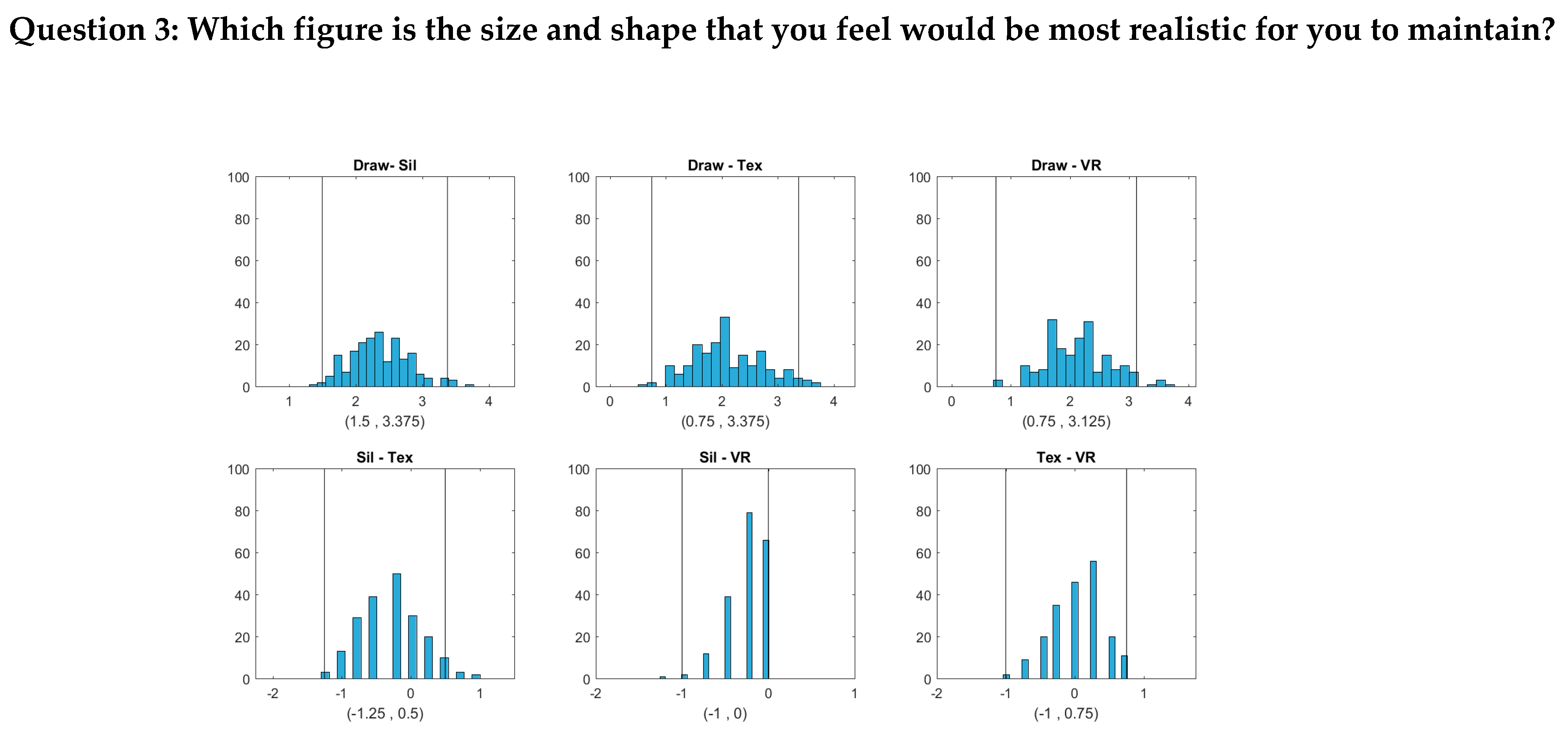
| Q1: Which Figure Best Reflects How You Think You Look Today? | Q2: Which Figure is the Size and Shape that You Would Most Like to Be? | Q3: Which Figure is the Size and Shape that You Feel Would Be Most Realistic for You to Maintain? | |||||||
|---|---|---|---|---|---|---|---|---|---|
| S5: My experiences when I meet new people | Draw Sil Tex | −0.933 −0.966 −0.982 | −0.202 −0.340 −0.389 | Draw | −0.973 | −0.222 | |||
| S6: My experiences at work/school | Draw Sil Tex | −0.962 −0.992 −0.994 | −0.415 −0.601 −0.696 | Sil Tex VR | −0.994 −0.947 −0.977 | −0.027 −0.205 −0.193 | Draw Sil Tex VR | −0.988 −0.987 −0.968 −0.962 | −0.594 −0.468 −0.639 −0.468 |
| S7: My relationships with friends | Tex | −0.985 | −0.540 | Tex | −0.842 | −0.013 | Draw Sil Tex VR | −0.951 −0.889 −0.969 −0.999 | −0.194 −0.222 −0.557 −0.501 |
| S8: My relationships with family members | Tex | −0.951 | −0.251 | Tex | −0.948 | −0.058 | Draw Tex | −0.978 −0.958 | −0.958 −0.188 |
| S13: My ability to control what and how much I eat | Draw VR | 0.160 0.036 | 0.947 0.994 | Sil Tex VR | 0.100 0.149 0.313 | 0.976 0.982 0.993 | |||
| S14: My ability to control my weight | VR | 0.070 | 0.998 | Sil Tex VR | 0.146 0.131 0.302 | 0.978 0.983 0.989 | |||
| S17: My daily “grooming” activities | Tex VR | −0.941 −0.915 | −0.182 −0.123 | ||||||
| S18: How confident I feel in my everyday life | Draw Sil Tex | −0.979 −0.915 −0.995 | −0.204 −0.285 −0.791 | Draw Sil Tex VR | −0.985 −0.962 −0.979 −0.948 | −0.389 −0.378 −0.631 −0.461 | |||
| S19: How happy I feel in my everyday life | Sil | −0.880 | −0.100 | ||||||
© 2020 by the authors. Licensee MDPI, Basel, Switzerland. This article is an open access article distributed under the terms and conditions of the Creative Commons Attribution (CC BY) license (http://creativecommons.org/licenses/by/4.0/).
Share and Cite
Hudson, G.M.; Lu, Y.; Zhang, X.; Hahn, J.; Zabal, J.E.; Latif, F.; Philbeck, J. The Development of a BMI-Guided Shape Morphing Technique and the Effects of an Individualized Figure Rating Scale on Self-Perception of Body Size. Eur. J. Investig. Health Psychol. Educ. 2020, 10, 579-594. https://doi.org/10.3390/ejihpe10020043
Hudson GM, Lu Y, Zhang X, Hahn J, Zabal JE, Latif F, Philbeck J. The Development of a BMI-Guided Shape Morphing Technique and the Effects of an Individualized Figure Rating Scale on Self-Perception of Body Size. European Journal of Investigation in Health, Psychology and Education. 2020; 10(2):579-594. https://doi.org/10.3390/ejihpe10020043
Chicago/Turabian StyleHudson, Geoffrey M., Yao Lu, Xiaoke Zhang, James Hahn, Johannah E. Zabal, Finza Latif, and John Philbeck. 2020. "The Development of a BMI-Guided Shape Morphing Technique and the Effects of an Individualized Figure Rating Scale on Self-Perception of Body Size" European Journal of Investigation in Health, Psychology and Education 10, no. 2: 579-594. https://doi.org/10.3390/ejihpe10020043
APA StyleHudson, G. M., Lu, Y., Zhang, X., Hahn, J., Zabal, J. E., Latif, F., & Philbeck, J. (2020). The Development of a BMI-Guided Shape Morphing Technique and the Effects of an Individualized Figure Rating Scale on Self-Perception of Body Size. European Journal of Investigation in Health, Psychology and Education, 10(2), 579-594. https://doi.org/10.3390/ejihpe10020043






